 Image search results - "koto-ku" Image search results - "koto-ku" |
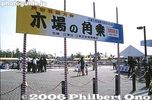
Kiba Park with Kiba Kakunori sign. Traditional folk performances are held on the same day as Koto Ward's Citizen's Festival in mid-Oct. So the park is quite crowded.
|
|
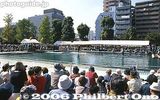
Huge crowd at Kakunori pond in Kiba Park.
|
|
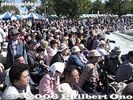
It starts at 11 am, so if you want a good view, go there early.
|
|

Kiba Sqaure Log Rolling is performed by the Kiba Kakunori Hozon-kai or Preservation Society. 木場角乗保存会
|
|

Kiba used to be where wood and lumber were stored and produced. 相乗り
|
|

Men managing the logs in the river eventually developed their own log tricks while on the job.
|
|

A long bamboo pole is used for balance.
|
|
|

Head stand
|
|
|

Double head stands
|
|

Without the bamboo pole, it is more difficult to keep your balance.
|
|

Splash!
|
|

Every three years (2017, 2020, 2023, 2026, etc.), the full-scale version of this festival is held in mid-Aug. The festival's last day is the climax with this procession of over 50 portable shrines. Led by this banner which reads Tomioka Hachimangu.
|
|

He tries again and succeeds in unfurling a banner which says "Koto Ward, Water Capital."
|
|

Shrine priest on horseback. The start of one of Tokyo's Big Three Festivals. These photos show the festival's climax on the last day of the festival when over 50 portable shrines are paraded along the streets amid splashing water. It is the Rengo
|
|

Woman roller.
|
|

Omiko shrine maidens. On the previous day during the Sacred Carriage Procession, they performed sacred dances on a truck. お巫女
|
|

Log rolling lessons are given at a local pool. Lot of children are good at it. I tried it once too. Very difficult...
|
|

Tekomai geisha. Their costume is colorful and partially masculine with trousers instead of skirts. Their right shoulder is "exposed" to show a peony flower (botan) design. They carry a red paper lantern imprinted with their names.
|
|

The middle of the foot must land on the corner to turn the log.
|
|

Tekomai geisha. They existed since the Edo Period. They served as side entertainment at festivals. They only sing traditional chant-like songs called kiyari. 手古舞
|
|
|

This troupe of 25 local women preserve a traditional art of Edo. They attend regular singing practice led by an elderly woman who was an authentic tekomai in her day.
|
|

Rolling with a fan. 扇子乗り
|
|

Rolling blindfolded.
|
|

Entrance to Kiyosumi Teien Gardens. Admission 150 yen.
|
|

Road to the Fukagawa-Edo Museum, near Kiyosumi-Shirakawa Station.
|
|

This is early in the morning when the 54 portable shrines who had gathered in front of the shrine depart for the procession one after another.
|
|

Blindfolded head stand.
|
|

This garden is very green. Even the pond is deep green. Kiyosumi Garden is classified as a "kaiyu-shiki teien" (回遊式庭園) or "circular-strolling Japanese garden." It's a common and classic Japanese garden design where you simply walk around the garden, usually around a central pond.
|
|

Fukagawa-Edo Museum
|
|

In front of Tomioka Hachimangu Shrine on Eitai-dori road.
|
|

Rolling with geta clogs. 駒下駄乗り
|
|

Iwasaki Yataro, the founder of the Mitsubishi Zaibatsu, acquired the estate in 1878 and developed the garden with a pond and famous stones brought from all over Japan.
|
|

After you enter the exhibition area, first you see drawings of famous people from Fukagawa.
|
|
|
|

The middle of the geta clog must land right on top of the log's corner.
|
|

Many matsu pine trees and many stones.
|
|

Then you see a dramatic bird's eye view of the recreated neighborhood of Sagacho, Fukagawa. The entire neighborhood is indoors.
|
|
|
|

Preparing for a head stand.
|
|

Stepping stones, called Isowatari, are another major feature of the garden.
|
|

The lighting inside the museum also changes to reflect the time of day. This is night time.
|
|

As the mikoshi depart, there is some entertainment at the Tomioka Hachimangu Shrine.
|
|
|

Stepping stones, called Isowatari. 磯渡り
|
|

Day time
|
|

Taiko drummers at Tomioka Hachimangu Shrine.
|
|

Isowatari. 磯渡り
|
|
|

Rice storehouse
|
|

In front of the shrine, a shrine priest blesses each portable shrine as it departs to join the procession.
|
|

Rolling with an umbrella. 唐笠乗り
|
|

Isowatari. 磯渡り
|
|

Cat on the roof. Meow is what you first hear in the museum. Its name is "Mamesuke." Actually a robot cat whose head can move up and down.
|
|

The portable shrines are paraded through a route which will take them almost all day to complete, from 7:30 am to 3 pm.
|
|
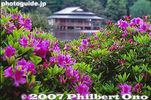
Azalea bushes and Ryotei teahouse
|
|

Father and son. He later turned around and rolled the other way with his son on his shoulders.
|
|

Main street with shops.
|
|

The mikoshi are splashed with water in whichever way possible. This is in the middle of summer, so it's a good way to cool off.
|
|
|

Acrobatics on a floating ladder. 梯子乗り
|
|

Vegetable seller. 八百屋の八百新
|
|

Each mikoshi is preceded by a row of women carrying lanterns and wands. Also see the video at YouTube
|
|
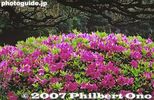
Pine branches and azaleas
|
|

Ladder stunts
|
|

Back room of the vegetable seller.
|
|

People in happi coats carry the mikoshi while shouting "Wasshoi, wasshoi!"
|
|

Red and white azaleas
|
|
|
|
|
|

Standard uniform of portable shrine bearers (for both men and women).The headband may be tied at the front or back of the head. It may also be tied on the head like a bonnet. There is a variety of ways of tying the headband.
The happi coat bears the name of the parish or district the person belongs to. The same name is displayed on the respective portable shrine. The shorts are white and skintight. Worn by both men and women. Also called Han-momo or Han-momohiki. The white tabi (sock-like shoe) has a rubber sole.
|
|
|

Ryotei teahouse 涼亭
|
|

Rice vendor. A small, wooden square box was used to measure the volume of rice to sell to a customer. 舂米屋職人
|
|
|

Huge and hungry carp
|
|

Bales of rice inside the rice storehouse.
|
|
|
|

A real crowd pleaser.
|
|

In case you fall into the pond...
|
|

Machikido town gate made of wood. This gate marked the boundary between towns. It could also be closed. 町木戸
|
|
|
|

The kanji "ki" (wood) is written on the his back on the left.
|
|

Taisho Memorial Hall
|
|

River boat taxi
|
|

"Hey Ho, Let's Go!"
|
|

The logs are moved around with a spike-tipped bamboo pole.
|
|

Big flower
|
|

River boat taxi
|
|
|
|

One of the highlight stunts...
|
|
|

Fire watchtower on the left, and boat operator's house on the right. 船宿升田屋と相模屋
|
|
|
|

This mikoshi is being carried by all women, already soaked to the bone. They carry the mikoshi flat on their shoulders. This is called "Hira katsugi," literally "flat carrying."There are four basic methods of carrying a portable shrine. This is the most basic method where they carry it flat on their shoulders. This is called "Hira katsugi," literally "flat carrying."
|
|
|

Bridge to a small island and gazebo
|
|

Boat operator's house 船宿升田屋と相模屋
|
|
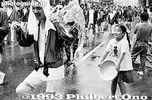
Splash you. This is a day when kids can be mean to grown-ups. This little girl kept filling up her bowl and ran around splashing some unlucky person.I hope that's her school teacher.
|
|

This year (2004), it was successful.
|
|

Gazebo on one of the three islands in the pond. あずまや
|
|

Cross section of a typical Nagaya longhouse apartment.
|
|

However, it is always possible that they splash down.
|
|
|

Nagaya longhouse
|
|

Water splashing truck near Kiyosu-bashi Bridge
|
|

Another highlight and difficult stunt.
|
|
|

Cross section of a typical Nagaya longhouse apartment. It was a single room whose size was about 6 tatami mats.
|
|

Water hose at Kiyosu-bashi Bridge
|
|
|

"Mt. Fuji" with azalea bushes blooming in early May.
|
|

Cross section of a typical Nagaya longhouse apartment. The saw on the wall indicates that the resident was a log cutter. The area was close to Kiba where they processed logs.
|
|

Crossing Kiyosu-bashi Bridge over Sumida River.
|
|
|
|

Clothes line for laundry.
|
|

Crossing Kiyosu-bashi Bridge
|
|
|
|

Communal toilet
|
|

Crossing Kiyosu-bashi Bridge
|
|

From the top of the blocks, he's supposed to jump onto the log in front. But he couldn't do it.
|
|
|

In front of the fire watchtower is this open area designed as a fire break to prevent any fires from spreading further. It is also a gathering place with food stalls.
|
|

Raising the mikoshi on Kiyosu-bashi Bridge
|
|

Crossing Kiyosu-bashi Bridge. They chant "wasshoi wasshoi!" as they carry the mikoshi. 清洲橋
|
|

Another guy tries to do it.
|
|

Tiny flowers
|
|
|
|

Crossing Kiyosu-bashi Bridge
|
|
|

Famous stone
|
|

Video theater
|
|
|
|

Exhibition room
|
|
|
|

He succeeds.
|
|
|

With raised arms, this is one way to carry the mikoshi.
|
|

Tekomai geisha from Tomioka Hachimangu Shrine walk toward the stage.
|
|
|
|

A horde of people follow each portable shrine.
|
|

They perform in mid-Oct. on the same day and place as Kiba Kakunori log rolling.
|
|

Ending chant. The performance is about 90 min.
|
|

Bird
|
|
|
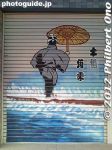
Store shutter art of Kiba kakunori in Koto, Tokyo.
|
|
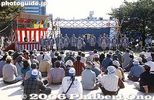
It is soon followed by the Kiba Kiyari troupe who chants Kiba workman songs.
|
|

Their right shoulder is "exposed" to show a peony flower design. Also see the video at YouTube.
|
|

Stone buddha
|
|
|
|

Below Ariake Station on Yurikamome Line 有明駅
|
|

They carry a red paper lantern imprinted with their names and use their right hand to drag along a metal wand.
|
|
|
|
|
|
|
|

The Kiba Kiyari songs were sung by men on the river in Kiba sorting out the logs. 木場の木遣
|
|
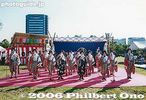
Tomioka Hachiman Tekomai geisha perform at Kiba Park.
|
|

Playground
|
|
|

Below Ariake Station on Yurikamome Line, very close to Tokyo Big Sight (on left) 有明駅
|
|
|
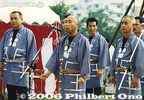
The men had to work together to move large logs on the water. They used the songs to match the rhythm of their work. The songs are said to have originated during the construction of Edo Castle by Tokugawa Ieyasu.
|
|

Iris garden
|
|

Phoenix atop a portable shrine.
|
|

Below Ariake Station on Yurikamome Line 有明駅
|
|
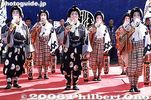
They only chant, no dancing.
|
|

They also perform the Kiba Kiyari Nembutsu which is a Buddhist chant. In the old days, Kiba's logging-related workmen performed this chant whenever someone in their trade met misfortune. 木場の木遣念仏
|
|

Basho Haiku Monument written with the famous haiku of the frog jumping into the pond. 芭蕉の句碑
|
|

Kiyosu-bashi Bridge over the Sumida River, Important Cultural Property 清洲橋 国の重要文化財
|
|

Below Ariake Station on Yurikamome Line 有明駅
|
|

Tomioka Hachiman tekomai geisha
|
|
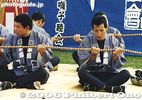
Kiba Kiyari Nembutsu. They hold and rotate a giant rosary while chanting. 木場の木遣念仏
|
|

Ryotei teahouse 涼亭
|
|

Crossing over Eitai-bashi Bridge. 永代橋
|
|

Ariake Chuo-bashi Bridge, near Ariake Station
|
|

A lion then appears.
|
|

Tomioka Hachiman tekomai geisha
|
|

Wisteria
|
|

Tekomai geisha cross Eitai-bashi Bridge to enter Koto Ward along Eitai-dori.
|
|
|
|
|
|
|
|
|
|
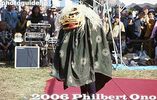
Lion dance.
|
|
|

Ryotei teahouse 涼亭
|
|

手古舞
|
|

Cheering section
|
|
|
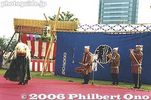
獅子舞
|
|
|
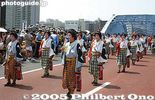
Tekomai geisha at Eitai-bashi
|
|

After this lion dance, the Fukagawa tekomai geisha performed.
|
|
|
|

Kasa-tei 傘亭
|
|

Tekomai geisha at Eitaibashi
|
|

During the finale, the tekomai and Kiba Kiyari singers sing together.
|
|
|
|

Tekomai geisha
|
|

Irises
|
|

They sing and chant while walking slowly.
|
|
|
|
|

Pine tree and Ryotei
|
|
|

Tokyo Big Sight in sight
|
|

Pine tree and Ryotei
|
|

They have flower hats, but I've never seen them wear it on their heads.
|
|

Running along Tokyo Big Sight
|
|
|
|

Tekomai geisha on Eitai-dori road, entering Koto Ward
|
|

Right turn here
|
|
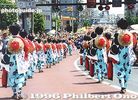
They do not get water splashed.
|
|

Stone pagoda on island named Matsushima
|
|
|

Stone lantern
|
|
|

Turning right for the finish line and posing for the photographer
|
|
|
|

Official photographer shoots the runners
|
|

Fukagawa Tekomai geisha make their entrance. 深川手古舞
|
|

A portable shrine crosses Eitai-bashi Bridge.
|
|

Final dash to the finish line
|
|
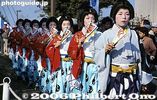
The Fukagawa Tekomai geisha make their way to the stage.
|
|

A portable shrine crosses Eitai-bashi Bridge.
|
|
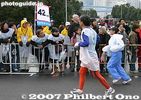
42 km mark
|
|

They chant without instruments.
|
|

Another portable shrine crosses Eitai-bashi Bridge.
|
|

Current time: 5 hr. 8 min. 15 sec.
|
|

Using a water hose is an efficient way to get people wet. But see what the big boys use..
|
|

Endless stream of runners heads for the finish.
|
|
|

A fire hose. The local fire department with a fire hose on Eitai-dori avenue.
|
|

Grandstands (wet) near the finish line
|
|
|

The water hose is now handled by volunteers, not real firemen.
|
|

Finish line grandstands
|
|

Each carry a lantern bearing their name.
|
|

Every time, the water hoses are at the same location.
|
|

Finish line grandstands
|
|
| 1887 files on 8 page(s) |
1 |
 |
 |
 |
 |
|